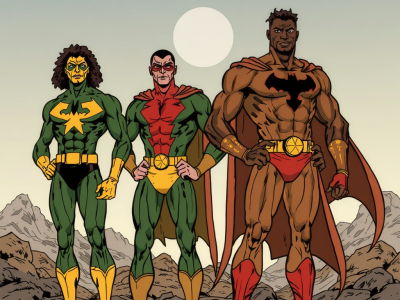Nubian Heroes Rise: African Historical Figures in Art & Film

Nubian Heroes Rise Again
“It’s a bird… It’s a plane… It’s Superman!”
We all remember that line. That jolt of wonder when Superman flew across a comic page. His cape. His strength. His power.
Comic books didn’t just entertain us—they shaped us.
They made us want to rescue stray cats like Superman. Stand up to bullies like Batman. Fight crime like Spider-Man. These paper heroes became our childhood role models, our dreams, our escape.
But what about Africa’s heroes?
Where were the children of the Nile? The warriors of Yoruba land? The goddesses of the rain and the wind?
Africa in Ink
For centuries, African stories were told through oral traditions, poetry, carvings, plays, and drums. But comics—graphic novels—have been one of the most underused tools for telling African stories.
That’s changing.
In 1966, the world met its first mainstream Black superhero: Black Panther.
Created by Stan Lee, Black Panther wasn’t just another character. He was T’Challa, King of Wakanda. A reflection of African pride, mysticism, and strength. Agile like a jungle cat. Deeply connected to nature. He drew his power from an ancestral herb, mirroring our traditional herbal knowledge.
T’Challa wasn’t fiction. He was a reminder and a mirror.
Long before comics, our ancestors were real-life heroes.
We farmed our land. We healed with herbs. We walked barefoot through jungles and deserts. Our skin resisted the harsh sun. Our bodies, hard and graceful. Our minds, wise.
The Zulu warriors could trek over 50 miles a day barefoot.
Our herbalists had cures. Our elders held wisdom.
Our strength inspired characters like Captain America. Our intellect? Reflected in villains like Bane.
Not Just One Hero
After Black Panther, more African-rooted characters followed.
-
Brother Voodoo, now known as Dr. Voodoo, embodied African spirituality.
-
Storm (Ororo Munroe), the weather goddess in Marvel’s X-Men, commanded the skies, echoing the powers of our rainmakers and priestesses.
But perhaps the most remarkable African presence in comics is the rise of the Orisha.
In Yoruba tradition, the Orishas are spiritual deities, each one a force of nature and morality.
Today, Orishas like Shango (god of thunder), Ogun (god of iron), Oshun (goddess of love), and Obatala (of the white cloth) have found their way into DC Comics, crossing paths with characters like Firestorm.
This is more than fiction. It’s cultural reclamation.
Why This Is Important
Graphic novels are powerful. They shape imagination. They carry ideas.
When our youth see heroes that look like them, move like them, and believe like them, something changes inside. Self-worth grows. Identity strengthens.
Yet, if we ignore our culture, it may slip through our fingers quietly.
We must not wait for outsiders to tell our stories. We must draw them ourselves—truthfully, powerfully, and with pride.
African culture isn’t fading. It’s alive. We just need to look again. Let’s raise our Nubian heroes, real and imagined. Let’s fill our books, screens, and stages with their fire, their glory, their truth. Africa has always had its heroes. Now, the world is finally watching.
#NubianHeroes #OrishaInComics #BlackPantherLegacy #Feelnubia
Read stories about African art
